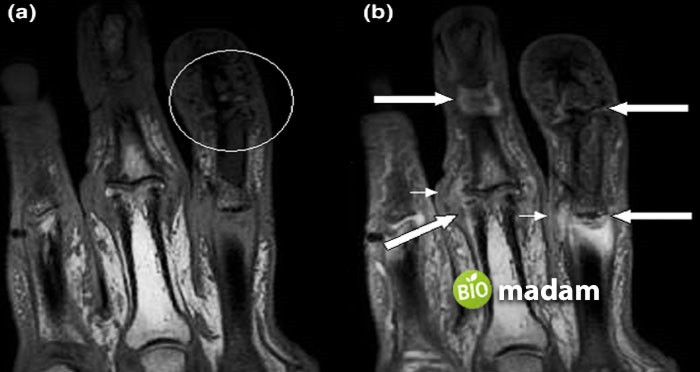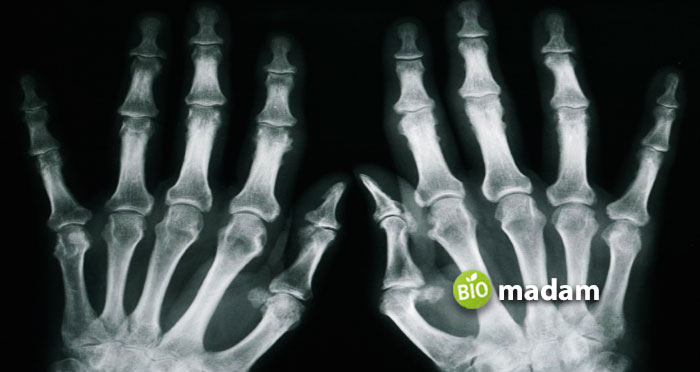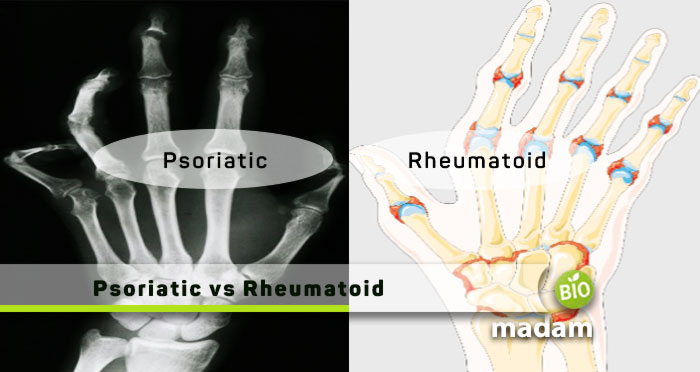Rheumatoid arthritis is a widely known type of arthritis, and many people are unaware of psoriatic arthritis. Psoriatic arthritis is another joint-inflammation condition that may go undiagnosed if you do not visit a doctor. Both have similar symptoms like stiffening, joint pain, and swelling. However, they are not identical and have distinguished characteristics that we will discuss further in the article. The most notable difference between rheumatoid arthritis and psoriatic arthritis is the coexistence of psoriasis in the latter.
You may identify psoriatic arthritis when you observe the signs and symptoms of psoriasis. But, what are they?
Keep reading to know everything that makes it easy to identify them from each other.
Comparison Table
| Factors | Rheumatoid Arthritis | Psoriatic Arthritis |
| Definition | Causing inflammation of the joints | Rising as a result of psoriasis |
| Acronym | RA | PsA |
| Prevalence | 1% globally | 0.25% globally |
| Risk Factors | Women, < 40 years | Psoriasis, family history |
| Symptoms | Joint pain, fatigue, joint stiffness, fever | Pelvic joints pain, and eye inflammation |
| Complications | Carpal tunnel syndrome, cervical myelopathy, etc. | Kidney disease, IBS, depression, diabetes, etc. |
What is Arthritis?
Arthritis is defined as swelling and stiffness of one or multiple joints. It is a systemic autoimmune disorder in which the body attacks its cells. Some types of arthritis come with age, while others are independent. Osteoarthritis and rheumatoid arthritis are prevalent types of arthritis, while psoriatic arthritis is relatively less common.
Arthritis Risk Factors
Arthritis is an autoimmune disorder, but some additional factors also affect its occurrence. For example, some types of arthritis may be related to lifestyle, while others arise in old age. Here are the risk factors typically associated with arthritis:
- Age: The chances of osteoarthritis increase as you get older.
- Gender: Women are more susceptible to rheumatoid arthritis than men.
- Lifestyle: Sometimes, a lack of exercise and an unhealthy lifestyle may elevate the risk of arthritis.
- Weight: Overweight people may exert pressure on the joints leading to pain and inflammation.
- Injury: Post-traumatic osteoarthritis may arise because of sports injuries such as a knee injury due to deterioration of joint cartilage.
Types of Arthritis
The five major types of arthritis are:
- Osteoarthritis
- Rheumatoid Arthritis
- Psoriatic Arthritis
- Lupus
- Gout
Rheumatoid Arthritis
Rheumatoid arthritis (RA) is the swelling and inflexibility of joints. It affects over 1% of the world population and 1.3 million adults in the USA.
This type of arthritis is a systemic autoimmune disorder in which the body cells attack the joint tissues. RA usually presents itself in more than one body art joint at one time, in a symmetric manner. For example, if you experience arthritis swelling in the fingers of the right hand, the swelling may also appear in the fingers of the other hand.
Rheumatoid arthritis is more common in women below the age of 40. People born with the gene HLA may experience an aggressive condition, especially with an unhealthy lifestyle and bad habits.

Symptoms of Rheumatoid Arthritis
- Joint pain and swelling
- Increased stiffness in the joints
- General Fatigue
- Dry eyes and dry mouth
- Inflammation of the eyes
- Loss of appetite
- Fever
Risk Factors
- Women are more susceptible to RA.
- Occurs in women below the age of 40 commonly.
- People with the HLA genotype II have higher chances of rheumatoid arthritis.
- Obesity and smoking are also rheumatoid arthritis risk contributors.
Rheumatoid Arthritis Complications
Rheumatoid arthritis must be managed in time to make sure that it does not lead to further complications like:
- Carpal tunnel syndrome
- Cervical Myelopathy
- Long-term joint damage
- Cardiovascular disease
Psoriatic Arthritis
Psoriatic arthritis is a complex form of arthritis combined with psoriasis. Reports show that around 30% of people with psoriasis also have arthritis.
In Psoriatic Arthritis (PsA), the immune system causes inflammation and joint pain. Moreover, psoriasis appears in the form of discolored patches known as plaque. They typically form due to excess epithelial cell buildup on the skin.
Unlike rheumatoid arthritis, psoriatic arthritis is not symmetrical and may affect only one side of the body. It is common in the back and pelvis joints besides fingers, toes, foot, and heel. PsA may also make your nails pit and flake. It affects epithelial and connective tissues by deteriorating ligaments and tendons attached to bones.
Psoriasis affects not only one of the two genders but is equally prevalent in men and women. It generally occurs in people between the ages of 30 to 50 years.

Symptoms of Psoriatic Arthritis
While the symptoms of rheumatoid and psoriatic arthritis are similar, you may distinguish them through these:
- Severe sacroiliac or back pain
- Inflammation in the eyes
- Swelling in fingers and toes
- Foot pain in the sole or heel
Risk Factors
- Psoriatic arthritis is quite common (30%) in people with psoriasis.
- Mostly PsA presents itself before the age of 40.
- A history of psoriasis or psoriatic arthritis in the family makes you more susceptible to PsA.
Psoriatic Arthritis Complications
Psoriatic arthritis must be controlled in time as any symptom, or both the conditions might aggravate. Some of the possible complications of Psoriatic arthritis include:
- Kidney diseases
- Diabetes
- IBS (Inflammatory Bowel Disease)
- Depression
Similarities between Rheumatoid and Psoriatic Arthritis
While there are numerous prominent differences between rheumatoid and psoriatic arthritis, they also have a few factors in common. Some of them are:
- Both are autoimmune diseases.
- They affect joints and cause inflammation.
- RA and PsA majorly affect fingers and toes.

Differences between Rheumatoid and Psoriatic Arthritis
Definition
Rheumatoid Arthritis
Rheumatoid arthritis is an autoimmune disorder resulting in swollen joints and is more common in women.
Psoriatic Arthritis
On the other hand, psoriatic arthritis is a condition in which patients simultaneously have psoriasis and joint inflammation.
Acronym
Rheumatoid Arthritis
Rheumatoid Arthritis is often known as RA.
Psoriatic Arthritis
Whereas, medical professionals refer to psoriatic arthritis as PsA.
Prevalence
Rheumatoid Arthritis
Rheumatoid arthritis is found in around 1% of the global population, with 3.1 million people suffering from the condition in the USA.
Psoriatic Arthritis
On the other hand, psoriatic arthritis is less common, with a 0.25% global prevalence.
Risk Factors
Rheumatoid Arthritis
It is more common in women under 40 and people of older age. Individuals having an HLA gene may also have an aggravated condition if they smoke or do not watch their weight.
Psoriatic Arthritis
However, psoriatic arthritis is more common in people with psoriasis and a family history of either disease. It also exhibits itself before the age of 40 years.
Symptoms
Rheumatoid Arthritis
Symptoms of RA include joint pain and swelling, stiff joints, dry eyes and mouth, general fatigue, loss of appetite, and fever.
Psoriatic Arthritis
Alternatively, PsA is characterized by severe sacroiliac or back pain, swelling in fingers and toes, foot pain in the sole or heel, and eye inflammation.
Complications
Rheumatoid Arthritis
If not managed in time, rheumatoid arthritis may lead to Carpal tunnel syndrome, cervical myelopathy, long-term joint damage, and cardiovascular disease.
Psoriatic Arthritis
Whereas untreated psoriatic arthritis may lead to kidney disease, IBS, diabetes, and depression.
The Bottom Line
Rheumatoid and psoriatic arthritis are among the most prevalent types of arthritis besides osteoarthritis. They both result from an autoimmune reaction where the body cells attack joints, causing them to swell and become stiff. No other particular reason is known behind RA, yet it is common in women below 40. On the other hand, PsA occurs widely in people with psoriasis. These conditions are different in their symptoms, risk factors, complications, and prevalence. However, they must be managed and treated timely to avoid any complications.
FAQs
How common is arthritis?
Over 50 million adults and 300,000 children in the USA suffer from some form of arthritis, and it is considered the most common cause of disability. Furthermore, the number is no less in the UK, and around 10 million people have arthritis.
Which is worse psoriatic arthritis or rheumatoid arthritis?
A 2015 research published in PLOS One journal reported that people with psoriatic arthritis have more joint pain with overall body pain and fatigue.
What makes psoriatic and rheumatoid arthritis so different?
Psoriatic arthritis and rheumatoid arthritis are not much different. However, their presentation varies. Rheumatoid arthritis is symmetric, while psoriatic does not follow symmetry and is quite common in people with psoriasis.
What are the six signs of psoriatic arthritis?
The main symptoms of psoriatic arthritis include inflammation in the finger and toes, difficulty in movement in the morning, and eye and pelvic joint inflammation.

Anna has completed her degree in Pharmacy from the University of Hawaii. She is serving as a research assistant in a pharmaceutical company. She had a great interest in writing blogs, traveling to different parts of the US, and trying delicious recipes in her spare time.

